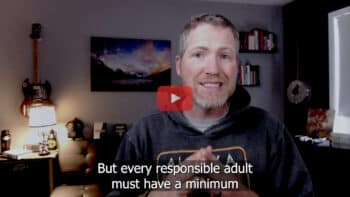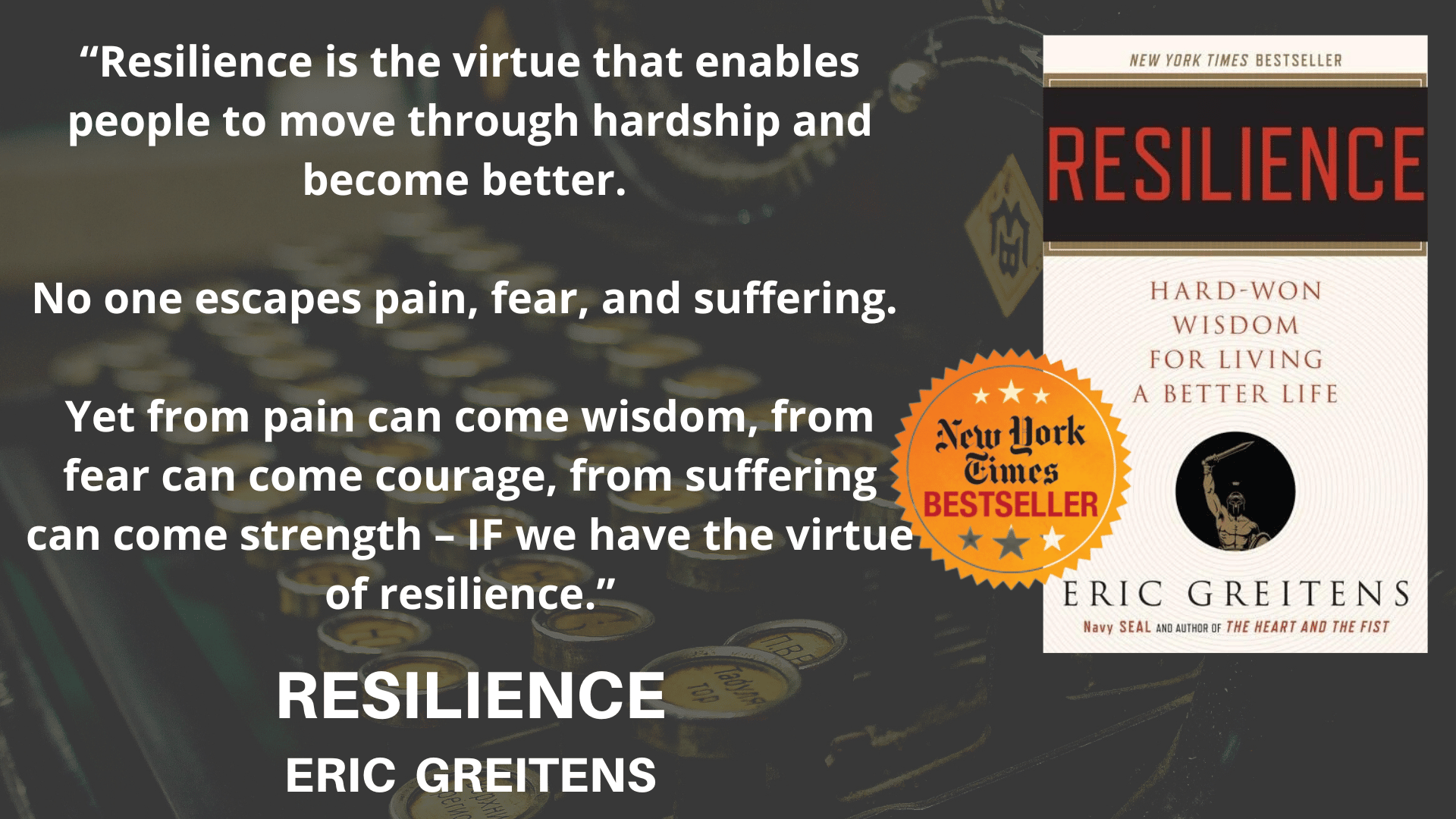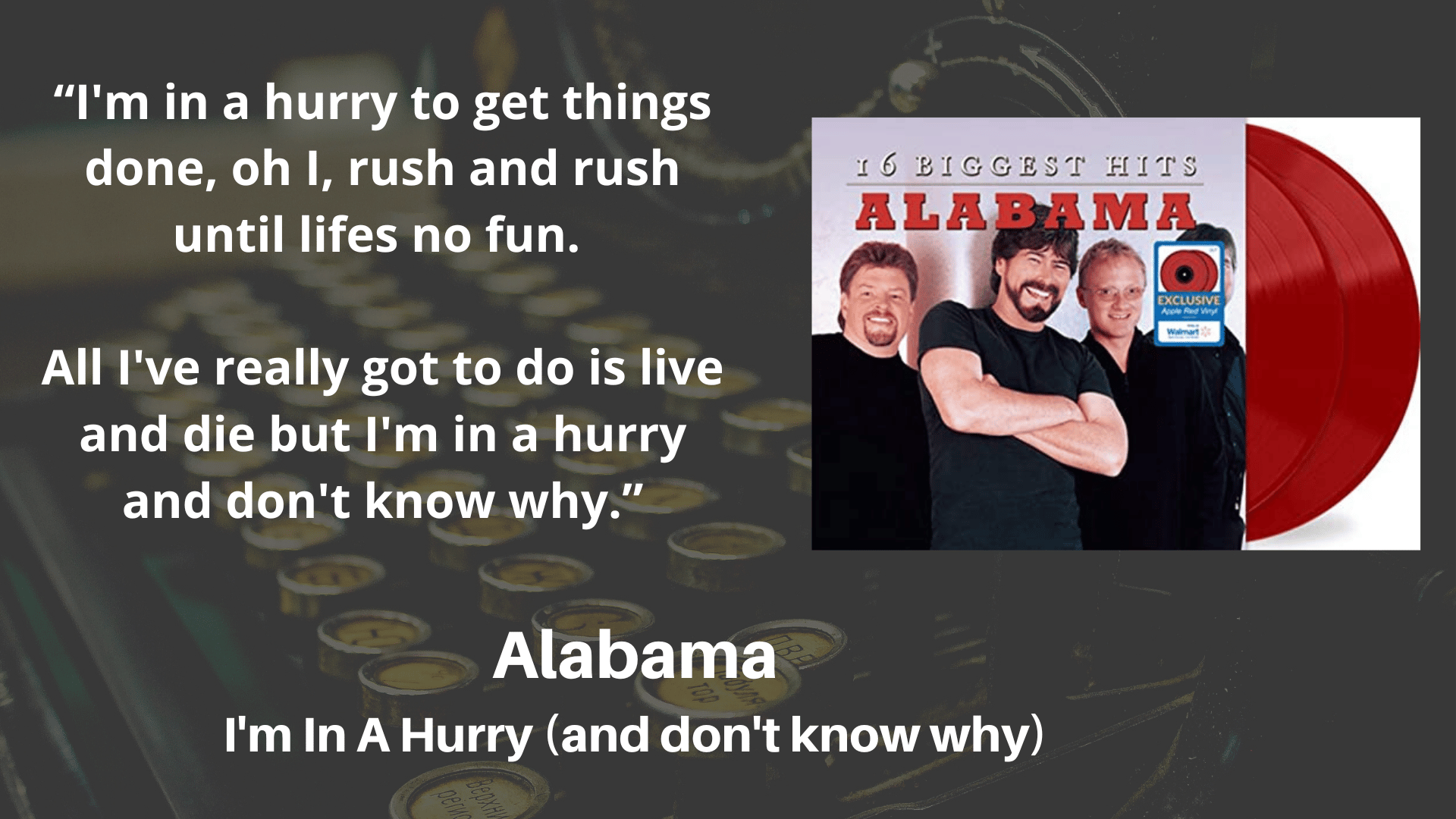The idea of being “Resilient” can be found EVERYWHERE in our modern culture.
If you listen close, you’ll hear it in interviews with elite athletes or used by powerful CEOs in motivational speeches.
Polished politicians and influential writers use it constantly. Why?
Why does it seem like everyone is chasing this virtue?
Because I believe it’s a key ingredient to living a better, more satisfying life. But what exactly is it? What does it take to be resilient? Heck, what does it mean?
Well, the truth is, it can mean different things to different people.
But I’m sure you’ll agree that being resilient usually means being both “mentally and physically tough” and having the ability to endure hardships.
It’s basically having enough mental, physical, and emotional resolve to overcome challenges in your life.
And while this covers the idea of resilience fairly well, I think Eric Greiten does a superb job of defining resilience in his book by the same name:
YES, I THINK he nails it; THAT’S exactly what resilience IS.
But even after you grasp resiliency at a broad level, it’s still too vague to help…right?
Sure, you get the gist, but how can you apply this virtue to your everyday life? How can you become a more resilient person?
I mean, you can’t just stop by the store on your way home from work and pick up a 5 lb sack of resiliency.
That’s why you need a roadmap. You need a checklist. An action plan to help assess and track how resilient (or fragile) you currently are…
And steps to make meaningful improvements.
Because, like any goal, you’ll struggle to improve without an action plan AND a way to track your progress.
So, while these broad ideas of “resiliency” and “mental toughness” are somewhat helpful, if you DON’T dig a bit deeper, the idea alone won’t create meaningful change.
So today, I’m going to give you a specific framework to become more resilient.
The first thing I want to do is break the idea of resiliency into 4 categories.
- Strategic Backups
- Physical Resiliency
- Mental Resiliency
- Emotional Resilience
Now let’s go through each of these in more detail.
Strategic Backups
Let me start by asking you a question…Which is better? Redundancy or Efficiency?
This is an important question because you can’t have both. “Redundant” and “efficient” are polar opposite ideas. Like oil and water, they don’t mix.
You can either become more efficient or more redundant. But as you gain one, you reduce the other.
So if you choose to increase your redundancy, you sacrifice some efficiency.

These backups helped ensure that if one of the main production lines broke down, the entire factory wouldn’t shut down.
And THAT strategy is what redundancy can do – it’s a strategic backup for critical systems.
So, if, let’s say, a critical liquid pump broke down during production, we could switch to the “redundant system” and keep running.
But these “strategic backups” are NOT FREE.
The extra pumps cost money to install and took labor to maintain. We had to store more parts in the stockroom.
I knew the real costs very well as the Maintenance Manager.
I wanted lots and lots of redundancy, but the factory accountants did NOT. They wanted efficiency and only allowed extra redundancy for the MOST critical systems.
You can often see this “redundant vs. efficiency” dilemma in financials, right?
For example, an emergency cash fund is a highly liquid strategic backup. But cash is one of the least efficient ways to store your money. Heck, with high inflation, it costs daily in purchasing power to keep a large emergency fund.
So, an emergency fund is redundant but NOT efficient.
Or how about critical medical supplies, such as masks and prescription drugs?
Sure, it’s way more “efficient” to get these supplies from foreign sources due to cheap labor. And it’s also more efficient to keep inventories low. Why? Because extensive inventories eat working capital, which businesses need to operate efficiently.
And choosing efficiency looks great when the world is running smoothly. But when bad things happen, efficiency will bite you in the ass.
That’s why anything we deem a critical supply should have a minimum level of redundancy in place before considering efficiencies.
And in your own life, what could be more critical than Water, Heat, Food & Medical Supplies?
Those are the critical items we ALL need to survive, right? Without these, your body will break down through dehydration, hypothermia, starvation, or disease.
But due to our modern society’s massive infrastructure and delivery systems. We’ve become complacent to these realities.
America (and most other first-world counties) have chosen efficiency over redundancy. We’ve put profit and greed ahead of robustness.
How do I know this?
A few years ago, I stumbled across a poll of Americans and their food and water backups. It found that 53% DID NOT have 3 days of nonperishable food or water in their homes.
53%.
That’s what I call the “fragile masses.”
So, the first step to becoming more resilient is to acquire some strategic backup supplies.
Now, I’m not talking about “dooms days prepping here. “ I’m talking about wise strategic backups that EVERY family should have.
Again 53% of Americans didn’t have 3 DAYS of life-supporting critical supplies. That’s more than just irresponsible; that’s gross negligence. That’s completely fragile.
So how many strategic backups should YOU have? That’s a difficult question, and I don’t have time to go into detail today. But subscribe to this YouTube channel because I’ll be covering that topic someday soon.
I’ll say this, deciding “how much” is a personal choice. Some folks are comfortable with a week. And that’s fine for the most likely emergencies.
Other folks prefer a month. Still, others go for multiple months or even a year.
Again, YOU get to choose how much is RIGHT for you and your family. BUT less than a week is NOT acceptable. I think the minimum for most folks should be at least a month.
OK, let’s move on to the next category of resiliency.
Physical Resiliency
Your body is NOT a machine.
Sure, there are a few similarities.
You have “parts” or organs that work together, and you give your body a constant source of energy – just like a machine.
But there is one MASSIVE difference between bodies and machines.
Bodies get stronger with frequent micro-stressors while machines break down.
This is how humans build muscle. It’s how you get stronger and how you avoid atrophy.
So be physically resilient, your need regular amounts of stress through exercise.
Want proof? Just look at the difference between a bedridden couch potato and a marathon runner.
Which body is physically more resilient? Obviously, the runner.
Of course, you can overstress your body and cause injury or even death.
For example, the “stress” of falling from a 30-foot building to a concrete parking lot is too much stress to overcome. Or, if you run a marathon without proper training, your injury risk would be high.
But if you, little by little, day by day, micro-stress your body, it will respond. And over time, it will become a more robust, more resilient organism.
So, a big part of living a resilient life is to focus on keeping your body healthy. Again, what this looks like is different for everyone. And I’m not a health expert or doctor…
But, it’s also not rocket science, “use it or lose it.”
OK, let’s move on to the next category of resiliency.

See how to find purpose & fulfilment through living a resilient life.
Mental Resiliency
Mental resiliency is all about becoming mentally tough. And it all comes down to YOU telling your body who’s in charge.
Doing hard, uncomfortable things and overcoming obstacles regularly, even if your mind is screaming NO. DON’T. STOP.
An example of such mental resiliency is taking a cold shower (or a cold plunge).
Is it uncomfortable? Absolutely. Will your brain scream DON’T DO IT? Without a doubt (especially if it’s your first time). But I PROMISE it won’t kill you.
And there’s immense value in understanding that.
What you “think” your body can handle vs. what it can actually handle is miles apart.
For example, I’ve read numerous studies of ultra-runners who think near the end of their race and feel like their body is at absolute limits. They feel like their bodies are about to collapse and fail.
But upon further analysis, their bodies are nowhere near that level of limitation. Sure, their bodies are exhausted, but technically, they are nowhere near failure.
So, most of the time, it’s NOT our bodies that hold us back, but our limiting beliefs.
So, to become more physically resilient, you must push past comfort, and THAT’s 100% mental.
And performing simple, safe mental resiliency challenges will also make you MORE grateful.
For example, by taking COLD showers, you’ll NOTICE and enjoy your hot showers more in the future. You’ll STOP taking them for granted!
Because doing mental resiliency challenges like this, helps create contrast in your life.
We’ve all heard the saying, “the sweet wouldn’t be nearly as enjoyable without the sour,” right?
The more contrast we experience in our lives, the more we can find joy in the small things.
You see, I believe constant comfort and luxuries are modern-day diseases.
They create mental weakness over time. Just like lying around weakens your muscles, always taking the mentally easy path weakens your resolve. It softens your soul.
And our modern-day technological wonders have made our society mentally squishy. Sorry, but it’s true.
Our ancestors were MUCH tougher mentally than we are today. And that’s why YOU need to focus on becoming more mentally tough if you want to be resilient.
You must actively swim against the lazy current.
You need to do uncomfortable things, such as taking cold showers, hiking in the rain, sleeping on the floor, skipping a few meals, and unplugging from screens.
Occasional challenges, such as these, will make you mentally tough AND more grateful for the modern-day comforts.
And being grateful is one of the best ways to be both mentally AND emotionally resilient.
Which is the next category on our list.
Emotional Resiliency
Humans are not entirely rational. Sure, we understand what being “rational” means, but as humans, we also have irrational emotions. We have feelings, desires, wants, and needs that control us, right?
Now, emotions are not ALL bad; they’re what make us human. Without feelings, we’d be organic robots.
Emotions allow us to experience joy, contentment, love, companionship, and gratitude. But with the good comes pain, such as loss, rejection, envy, hate, and loneliness.
So, to become emotionally resilient, you want to decrease the frequency and severity of destructive emotions and increase the positive ones.
Now again, I’m not a doctor or a psychiatrist. I’m an engineer. And some folks have more going on than just regular human emotions. Some people have legit chemical imbalances or past traumas to deal with and should seek professional help.
But I also believe most people can benefit from changing their perspective. And I think the three most important virtues of being emotionally resilient are:
- Relentless Courage
- Immense Patience
- Overwhelming Gratitude
Again, I don’t have time to dive deep into each of these virtues today. But if you can shift to focusing more on these three positive emotional states, you’ll automatically become more emotionally resilient.
For example, it’s impossible to feel overwhelming gratitude and anger at the same time.
It CANNOT be done.
But your gratitude must be REAL. If you’re faking, you can pretend to be grateful, but you’ll still harbor resentment in your heart.
Instead, if you can foster TRUE, AUTHENTIC gratitude, then there’s no space for negative emotions to take root.
So if you can keep your heart filled with gratitude, you’ll push out the hate, the envy, and the anger.
And immense patience is also an essential trait for emotional well-being.
I love the lyrics from the song “I’m in a hurry” by the band Alabama:
Why the hell are we all in a constant state of frenzy?
- We rush to work; then we rush home…
- We rush to the concert and then leave early to beat the traffic.
- We rush to the airport because we’re late and then get upset when the security line is doing too good of a job…
- We knowingly procrastinate, then rush around like a maniac to meet our deadlines…
What are we all chasing? Why are we all rushing through THIS moment right now?
To get to a future moment (that doesn’t really exist)…
A future moment we “think” will be better than the present one?
Only to discover, when we arrive at THAT “better” future, we’re already concentrating on the next “better” future…
It’s insane.
Instead, if you learn to be more patient with others AND (more importantly) with yourself, you’ll enjoy your life more and appreciate others more.
Chronic impatience is a breeding ground for negative emotions. It’s a fertilizer for emotional weeds to grow.
And finally, we could all use more courage, right? I believe courage it’s the key to discovering happiness and freedom. Why? Because being courageous means accepting rejection.
You see, we all feel judged by others. That is why we care about what we wear, what we drive, and the people we hang out with. These are ways we all virtue signal. It’s one of the main ways we avoid rejection.
If we “fit in,” we have worth.
And we ALL fear rejection, right? It’s a built-in human fear. It’s part of the reason why we rush around. We want to prove to others (and ourselves) that we’re worthy…
So, to stop living your life to appease others, you must work on being more courageous. Stop being fearful of what others think of you. To “put yourself out there” and share your work and talents with the world.
Not because you fear what others think, but because YOU like it. YOU enjoy it, regardless of others.
Because, without courage in your life, you’ll slowly build up regrets. And one of the saddest things to witness is someone who looks back on their life and is filled with overwhelming regret.
So, to combat regret, you must be courageous.
If you focus on these 4 key aspects of resiliency, you’ll go from being part of the “fragile masses” to living a more fulfilling, happier, resilient life.
And as you can tell, living a resilient life is the key to reducing anxiety and creating more satisfaction, joy, and happiness in your life.
- You can gain lasting peace of mind with strategic backups.
- You foster feelings of confidence and satisfaction with a strong, healthy body.
- You can strengthen your mental toughness by overcoming challenges and obstacles.
- And you can become a more courageous, patient, and gracious human being.
If these traits sound like something YOU want more of in your life, I highly recommend you check out The Resilient Life. It’s a program I’ve built myself from the ground up to help YOU become more resilient and more satisfied with your life.
This program is rooted in all 4 of these powerful resiliency categories. It provides you with regular challenges straight to your email each week. It also has success badges you can tackle as you get your strategic backups in place.
And as you overcome these obstacles, take on challenges and build your strategic backups, The Resilient Life will track your progress! Every time you act, you’ll gain points and see your resiliency score increase. This tracking system will help to keep you motivated and inspired.
The Resilient Life is also a community. It’s full of highly engaged folks who gladly share their successes and are willing to answer questions or give a few words of encouragement.
If this all sounds like a program, you’d like to be a part of, schedule a call using the calendar below, and somebody from our team will meet with you on Zoom to see if The Resilient Life is a good fit.
If you have any questions, email support@theresilientlife.com.
And until next time, Prepare, Adapt, and Overcome,

"Just in Case" Jack
Co-Founder of TheResilientLife.com and SkilledSurvival.com. Creates content, helps members, and is the visionary behind The Resilient Life’s way of living. Husband, father, mechanical engineer, survivalist, and prepper.
See how to find purpose & fulfilment through living a resilient life.




